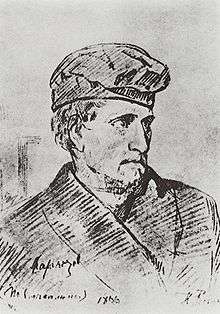Dmitry Karakozov
| Dmitry Karakozov | |
|---|---|
 Portrait of D. V. Karakozov by Ilya Repin (1866) | |
| Born |
October 23, 1840 – November 4, 1840 Kostroma, Russia |
| Died |
September 3, 1866 – September 15, 1866 St. Petersburg, Russia |
Dmitry Vladimirovich Karakozov (Дмитрий Владимирович Каракозов in Russian) (October 23 Old Style (November 4 New Style), 1840 – September 3 Old Style (September 15 New Style), 1866) was the first Russian revolutionary to make an attempt on the life of a tsar.
Karakozov was born in the family of a minor nobility in Kostroma. He grew to hate his class because all they did was "suck the peasants' blood." He studied at Kazan University 1861-64 and at Moscow State University 1864-66. He was expelled from both which led to depression and a failed suicide bid. In early 1866 he became a member of the "revolutionary wing" of the Ishutin Society, founded by his cousin Nikolai Ishutin in Moscow in 1863. In the spring of 1866, Karakozov arrived in St Petersburg to assassinate Alexander II. He circulated his hand-written proclamation called "Друзьям-рабочим" ("To Friends-Workers"), in which he incited people to revolt. He wrote a manifesto to the St Petersburg governor blaming the Tsar for the suffering of the poor: "I have decided to destroy the evil Tsar, and to die for my beloved people."[1] This note never reached anyone; it was lost in the mail.[2] It is possible 1866 was the year chosen because of the character of Rakhmetov in What Is to Be Done?. This fictional inspiration of revolutionary youth plans for a revolution to coincide with the apocalypse according to Newton-1866.[3]
Attempted assassination of Alexander II
I have long been tormented by the thought and given no rest by my doubts why my beloved simple Russian people has to suffer so much! ... Why next to the eternal simple peasant and labourer in his factory and workshop are there people who do nothing – idle nobles, a horde of officials and other wealthy people, all living in shining houses? I have looked for the reason for all this in books, and I have found it. The man really responsible is the Tsar. ... the Tsar is the first of the nobles. He never holds out his hand to the people because he is himself the people's worst enemy.
On 4 April 1866, Dmitry Karakozov made an unsuccessful attempt on the life of Tsar Alexander II at the gates of the Summer Garden in St Petersburg. As the Tsar was leaving, Dmitry rushed forward to fire. The attempt was thwarted by Ossip Komissarov, a peasant-born hatter's apprentice, who jostled Karakozov's elbow just before the shot was fired. Contemporary monarchists argued that Komissarov's action proved the people's love for their tsar, while contemporary radicals and later Soviet historians argued that Komissarov's involvement in the event was either an accident or an outright government fabrication. Komissarov was ennobled and given a generous allowance, but proved to be an embarrassment to the government due to his boorishness and incoherence and had to be politely removed to the countryside.
Karakozov tried to flee instead of using the second cartridge in his double-barrelled gun, but was easily caught by the guards. He kept one hand in his jacket. It was revealed later to be holding morphine and strychnine to kill himself and prussic acid to disfigure his face. Alexander asked him "What do you want?" "Nothing, nothing," he replied.[6] He was taken to the Peter and Paul Fortress. Karakozov begged for forgiveness and converted to Russian Orthodoxy. The Supreme Criminal Court sentenced him to death by hanging and he was executed in St. Petersburg on 3 September 1866. Ten of his accomplices were sentenced to hard labor, another 25 were acquitted. As a result of the assassination attempt, the Tsar punished St Petersburg University. Students could no longer form any kind of organisation, no matter how harmless (Ishutin's organisation had officially been to set up sewing cooperatives). They were subjected to constant surveillance and periodic searches.
Karakozov was an inspiration for the radical nihilists Sergei Nechaev and Vera Zasulich.[7]
Notes
- ^ See, e.g., Adam Bruno Ulam. Prophets and Conspirators in Pre-Revolutionary Russia, New Brunswick, NJ, Transaction Publishers, 1998 (first edition 1977) ISBN 0-7658-0443-3 pp. 3–5.
- ^ For an analysis of the public perception of the assassination attempt and Komissarov's actions, see Richard S. Wortman. Scenarios of Power: Myth and Ceremony in Russian Monarchy: Volume Two: From Alexander II to the Abdication of Nicholas II, Princeton University Press, 2004; ISBN 0-691-02947-4, pp. 110–13
- Claudia Verhoeven. The Odd Man Karakozov: Imperial Russia, Modernity and the Birth of Terrorism, Ithaca: Cornell University Press, 2009, ISBN 978-0-8014-4652-8
References
- ↑ Ana Siljak, Angel of Vengeance, page 79
- ↑ Ana Siljak, Angel of Vengeance, page 110
- ↑ Ana Siljak, Angel of Vengeance, page 82
- ↑ "1866: Dmitry Karakozov". ExecutedToday.com.
- ↑ Geoffrey A. Hosking (1997). Russia: People and Empire, 1552-1917. Harvard University Press. p. 347. ISBN 978-0-674-78118-4.
- ↑ Ana Siljak, Angel of Vengeance, page 79
- ↑ Ana Siljak, Angel of Vengeance, p. 92